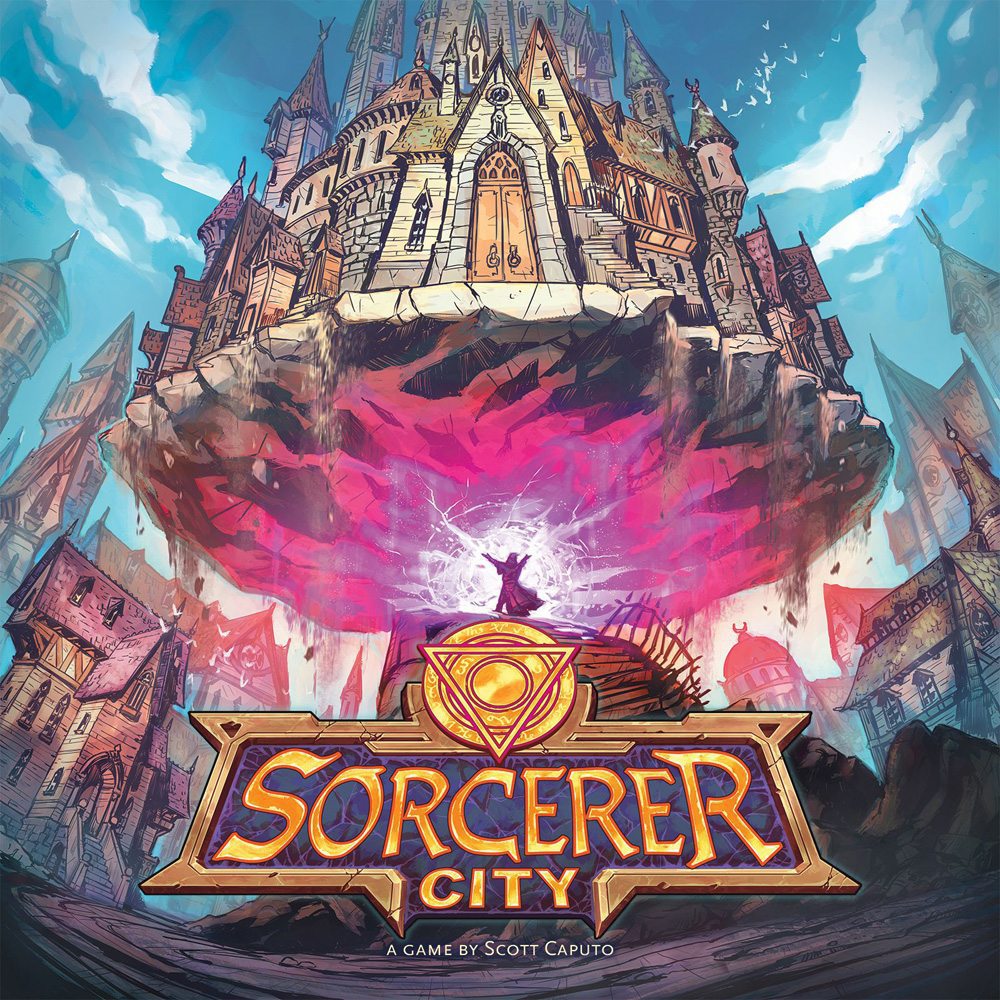Sorcerer City is rebuilt every year, with rival wizard architects competing for prestige. Can you outbuild your opponents and work around the monsters that infiltrate the city?
What Is Sorcerer City?
Sorcerer City is a real-time tile-laying game by Scott Caputo for 2 to 4* players, ages 14 and up, and takes about 40–60 minutes to play. It’s currently seeking funding on Kickstarter, with a pledge level of $49 for a copy of the game, or $69 for the deluxe edition. I think the game is fine for younger players as well—there is nothing thematically inappropriate for any age, so the primary limitation is in the ability to plan strategically while under some time pressure.
*Up to 5 players if the stretch goal is reached.
New to Kickstarter? Check out our crowdfunding primer, and visit our Kickstarter curated page for more projects we love.
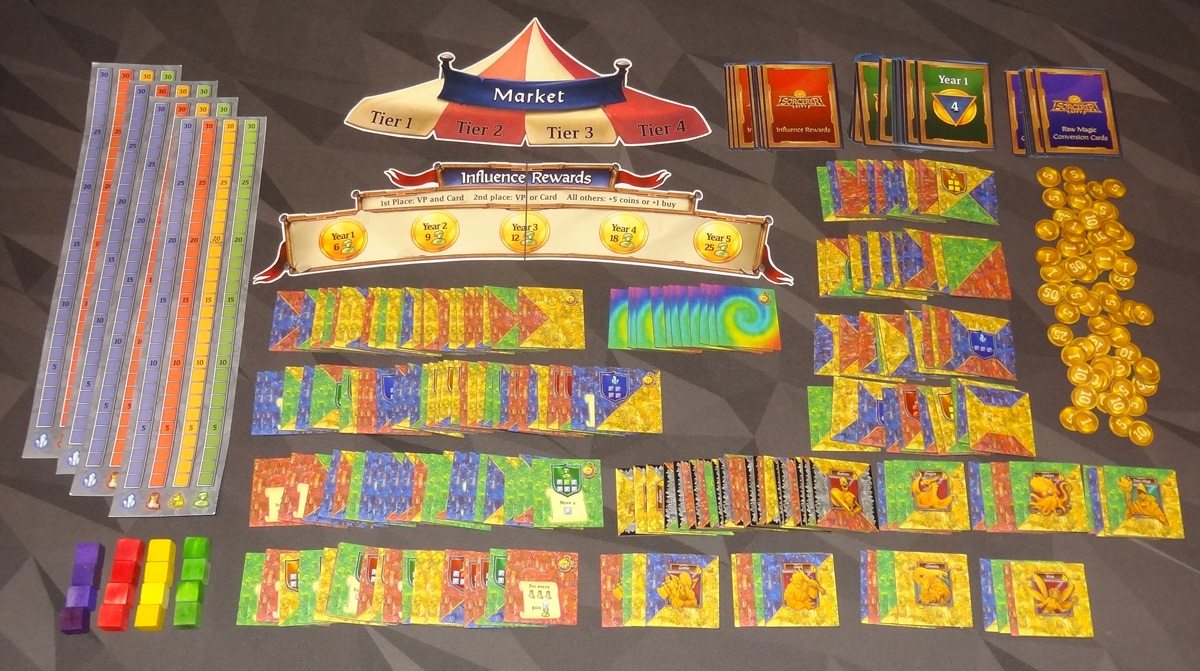
Sorcerer City Components
Note: My review is based on a prototype copy, so it is subject to change and may not reflect final component quality. Visit the Kickstarter page for the most updated artwork!
The game will include:
- 48 Starter tiles (12 per player)
- 4 Score Tracker boards
- 16 Tracker tokens (4 per player)
- 16 Surplus tokens (4 per player)
- 12 Magic Conversion cards (3 per player)
- 78 Market tiles
- 66 monster tiles
- 12 Rainbow tiles
- Market board
- Influence Rewards board
- 80 Prestige tokens
- 8 Influence Reward cards
- 2-minute timer
- 15 Mystery Player cards (for 2-player game)

The component list may change based on stretch goals in the campaign, but this is what is currently included. The deluxe edition is similar, but will also include interlocking metal prestige tokens, as well as a Kickstarter Token of Valor (for bragging rights) and a fancier box.
The primary component in the game is the tiles—lots and lots of square tiles. There are four different colors on the tiles, representing the four districts: purple produces magic, yellow produces money, red produces influence, and green produces prestige (victory points). The tiles have various patterns, and some have shields, which are needed to score the various resources. The icons used for the resources weren’t immediately intuitive to me: money is represented by a tent (for markets) rather than, say, a bag of coins. Prestige is a green person. Influence is a rook-shaped tower.

The shields are all marked with icons and have different colors to help you distinguish them. I was concerned that color blind players may have difficulty distinguishing the red, green, and yellow color areas, and I was informed that the background illustrations actually have different details that did not show up well in the prototypes. The image above shows that purple has crystal towers and rounded trees, red has rook-like towers and rocks, yellow has market tents and market stalls, and green has a lot of trees. However, I still think those may be a little hard to differentiate at a glance—particularly because the building phase is timed. So if you’re color blind and you’re interested in the game, take a look at the image above to see how easily you can tell the four colors apart.
How to Play Sorcerer City
You can download a copy of the rulebook here.
The Goal
The goal of the game is to earn the most prestige after five “years” of building and rebuilding your district.

Setup
In the center of the table, you set up the tile market, the influence rewards, and the monsters. The market tiles are divided into 4 tiers, indicated on the backs of the tiles. Shuffle each tier separately, place the stacks in the corresponding spaces under the market board, and then reveal the top three tiles of each tier. Place the stack of rainbow tiles next to the market as well.
Under the Influence Rewards board, deal out four random influence reward cards. Some are marked not to use for Year 1. (There will be a card for Year 5 that says “no influence reward.”)
There are two tiers of monsters. Choose two from Tier 1 and place them below Years 1 and 2. Choose two from Tier 2 and place them below Years 3 and 4. No monsters are placed below Year 5.
Place the prestige tokens nearby in a supply.

Each player gets three magic conversion cards and the starting set of 12 tiles. Each player will also get a score tracker board, plus the tracker tokens and surplus tokens. The score board goes up to 30, and the surplus tokens indicate that you have wrapped past 30, but you max out at 60 in a round.
Choose a player to be starting player and hand them the timer.

If it’s a 2-player game, you also set out five of the mystery player cards, one for each year—shuffle each year and choose one at random, placing them face-down.
Gameplay
Each round (or “year”) has a few phases:
- Building Districts
- Magic Conversion
- Influence Rewards
- Buy Tiles
- Collect Prestige
- Monsters
Let’s take a closer look at each phase.

Building Districts
The building phase is timed: players have 2 minutes and everyone plays simultaneously. Everyone shuffles their tiles and places them in a stack face-down—we also had other players cut the stacks. Then, when the timer starts, players reveal tiles one at a time, each player building their own district.

Important rules about building:
- A tile must be placed orthogonally adjacent to at least one other tile (except the first tile, of course).
- Once placed, a tile may not be moved.
- Colors do not have to match when you place tiles, though there are often advantages for doing so.
- When the time runs out, you must stop immediately.
Then, each player scores their district, marking the magic, influence, money, and prestige on their own scoring track. There are three types of goals (represented by the shields), each of which scores in a different way for one of the resources. Note: you must score at least 3 points for a goal, or it does not score anything at all.

The line goals, shown above, show three squares in a line. For these, you score 1 point of the corresponding resource for each connected tile of that color in a straight line. If you have the red shield in a line of 4 tiles that all form one continuous red line, you score 4 influence. Lines are broken if the color is not connected or turns a corner.

Area goals show a 2×2 grid of squares. You score 1 point for each connected tile of that color, regardless of the shape. The more tiles you can connect of that color, the more you score.

Shield goals show a colored square with five shield icons around it. (There weren’t any purple or yellow shield goals that didn’t also include a green shield goal, so that’s what is pictured above.) To score a shield goal, you count 1 point per tile with a shield that is surrounding it (orthogonal or diagonal), as well as 1 point for itself. So a shield goal that has 3 other shields of any type nearby would score 4 points. For shield goals, it doesn’t matter if color areas are connected or not—just whether they are surrounded by more shields.
Players total up their scores. You may only earn up to 60 of any resource in a given round.

Magic Conversion
The magic conversion cards show influence, magic, and prestige. Each player chooses one secretly, and then the cards are revealed simultaneously. You spend all of your magic and gain the resource that you chose.

Influence Rewards
Having the most influence brings you prestige and rewards! The influence rewards board shows prestige values for each year (6, 9, 12, 18, and 25), and the reward cards are randomized each game.
The first place player gets the prestige and the reward printed on the card. Second place chooses prestige or the card, and third place gets whatever the second place did not choose. Everyone else gets either +5 money or +1 buy for the market phase.
In case of ties, all tied players receive the award, but it may effect the next place. (For instance, if there’s a tie for 2nd, then there is no third place award.)
In a two-player game, you reveal the mystery player card for the corresponding year—this shows the mystery player’s influence level. If you are third place in a 2-player game, you get either 5 gold or 1 extra buy. The mystery player does not do anything else except compete for placement in influence.

Buy Tiles
After the influence rewards, players may buy tiles from the market using their money. By default, you may purchase up to 2 tiles; if you reach 20 or more gold, you get another buy, and there may be other effects that get you additional buys.
The market tiles are arranged into four tiers, with three tiles showing from each tier. You may spend 1 gold to cycle a tile to the bottom of its stack and reveal the next one, and any time you purchase a tile you immediately reveal a new tile. The price ranges increase from Tier 1 to Tier 4, and there is a mix of tiles with goals and spells. Spells, which look like scrolls, may be used once per round after they’re placed in your district. Some let you manipulate tiles in your district, and others may let you score more points or give you benefits during the buying phase.

There are also rainbow tiles in the market, available for 8 gold. Rainbow tiles count as all colors simultaneously, so that multiple colors can connect through them. In the photo above, the rainbow tile helps the purple line goal connect across for 4 magic, and it also allows the yellow area goal to connect up for 5 gold.
Collect Prestige
After everyone has had a chance to buy tiles, you get prestige coins equal to your prestige score, and then reset all of your score trackers to 0.

Monsters
Finally, at the end of the round, the monsters show up! There is one monster type for each year—everyone gets a random monster tile of that type. (For skeletons, you get two tiles instead of one.) These are shuffled into your tile stack along with all of your starting tiles and any tiles you have purchased.
Monsters with an exclamation point have effects as soon as you flip them over, and other monsters will have an effect at the end of the round if they are in your city. Here’s a quick summary of the monster effects:
- Kraken: Immediately remove 3 tiles from your district and place them back at the bottom of your deck.
- Dark Mage: Any shields surrounding the dark mage do not score at all.
- Dragon: Place the dragon, and then immediately destroy (remove from the game) one adjacent tile.
- Skeleton: Nothing can touch the grey sides of the tile.
- Giant: Immediately place on top of a tile that has a purchase cost, if any. Otherwise play normally.
- Pixie: Immediately place on top of a tile that has a shield, if any. Otherwise play normally.
- Chimera: At the end of the building phase, destroy one tile with a shield in the Chimera’s row or column, if any.
- Goblin: Immediately discard two tiles with gold on them—these cannot be used this round but will get shuffled back in for the next round.
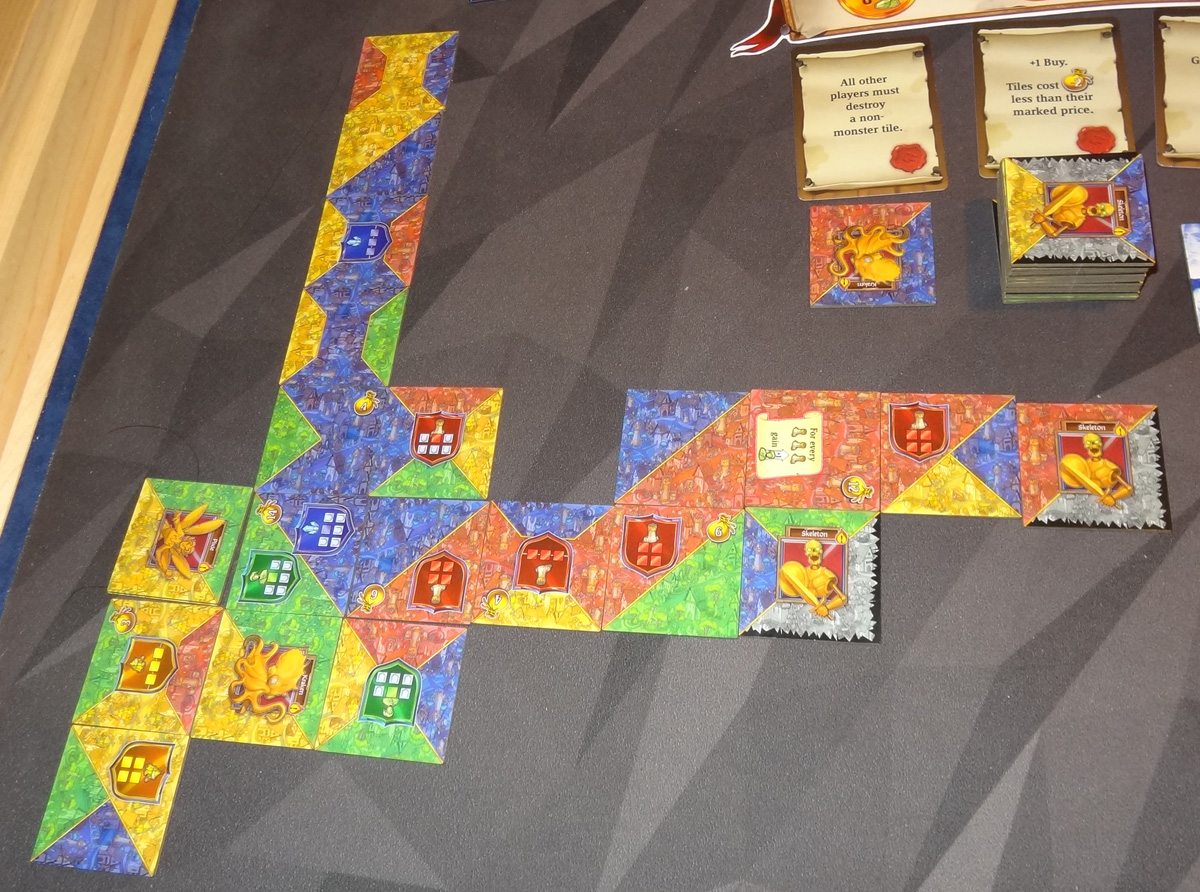
Game End
The game ends after the fifth year. In Year 5, there is no influence reward—the player with the highest influence gets 25 prestige, and no other places are awarded anything. You skip buying tiles and gaining monsters, and just score as normal.
The highest prestige wins, with ties going to the player with more gold.
Why You Should Play Sorcerer City
Sorcerer City is a mash-up of tile-laying and deck-building, both genres that I really enjoy. Throw in a dash of real-time play, and it’s easy to see why I’m a fan. Let’s break that down a bit.

One of my first introductions to modern board games was Carcassonne, a tile-laying game that I still play pretty regularly (though usually on my phone). I like spatial reasoning, trying to figure out the best place to put a tile to maximize my score (or leave open potential for scoring). I like maps, and I love the way many tile-laying games result in a completed map when you’re done. Sorcerer City feels a little like Carcassonne or Kingdomino in that respect, because you’re trying to score for as many of your shields as possible, and so it scratches that puzzle-solving itch for me.
Deck-building games are usually card games, with Dominion being the originator of the mechanic (though there are also “bag-building” games that involve putting resource cubes into a bag). Each player starts with a basic set of cards and, over the course of the game, adds new (usually more powerful) cards to their own deck. In Sorcerer City, you have a stack of tiles instead of a deck of cards, but it works in a similar way: you use your tiles to earn money (and other resources), and then use that money to buy additional tiles, to help you gain more money (or other resources) in future rounds. You’ll often find yourself deciding between buying one expensive tile or two cheaper tiles. And there’s also a press-your-luck element to paying to cycle the market, looking for the one that you want—or, if you know another player really wants a tile, you can hate-draft by paying to put it at the bottom of the stack.
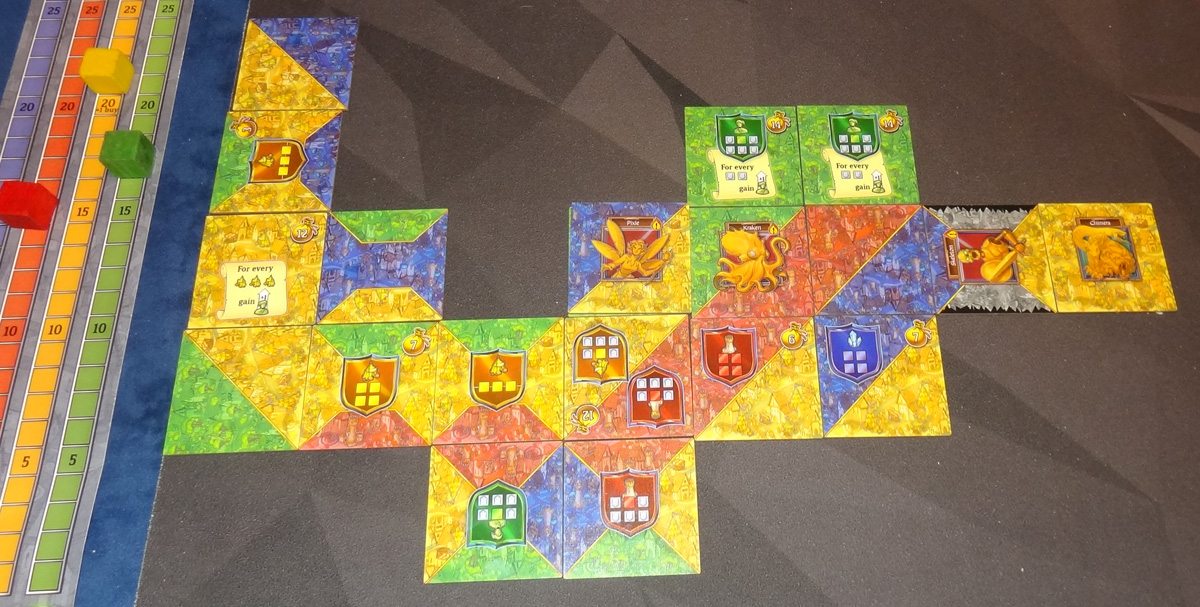
The monsters are an interesting twist, too: they’re like the negative cards that appear in some deck-building games. You don’t want them in your deck, and you have to figure out how to work around them if you draw them. But it’s not all terrible: the monster tiles have colors, so you can still use them to connect areas and lines to complete goals, and sometimes you can even use them to your benefit, like getting rid of tiles (even other monsters!) with your dragon tile.
As with other deck-building games, you have to decide how you want to use your tiles. Do you focus on influence, to try to get the rewards and rely on the prestige bonuses for your score? Or do you go for money, so that you can buy more powerful tiles? Or maybe you max out your magic production, because it gives you the most flexibility to choose between influence, money, and prestige? By the last round, though, money is useless (except as a tie-breaker) and so there is a natural progression toward prestige and influence by the end.
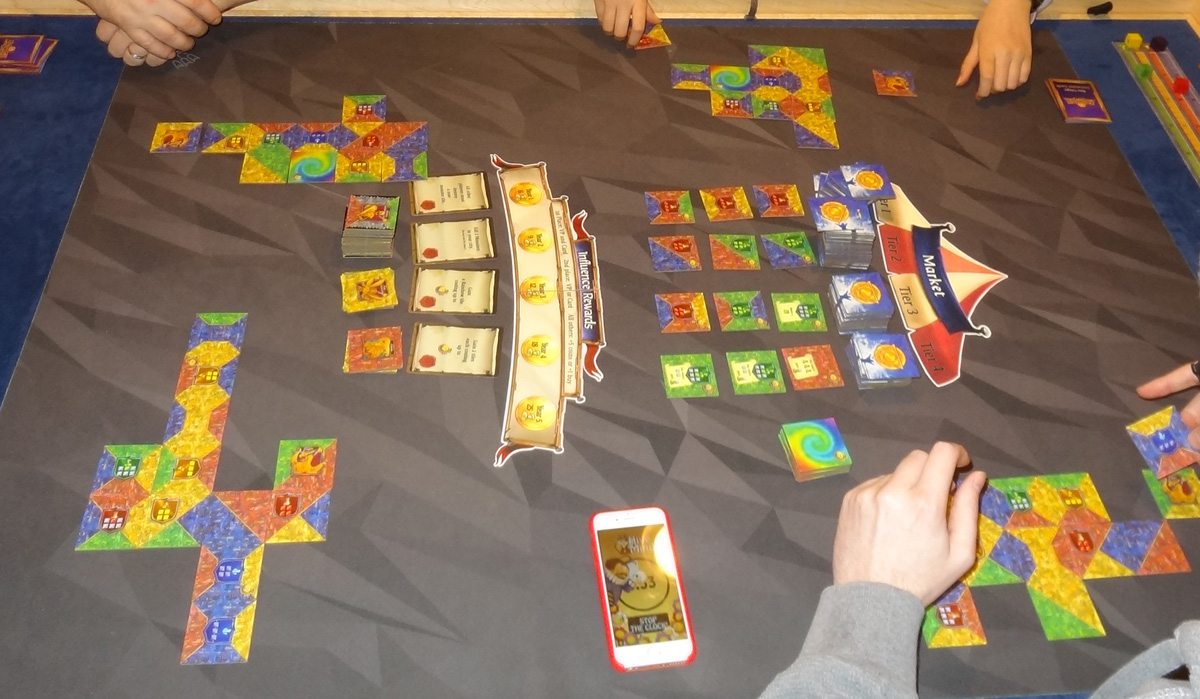
(Prototype shown) Photo: Jonathan H. Liu
And then, finally, there’s the real-time aspect.
Not everyone likes real-time games, and I think for less experienced players you could decide as a group whether to allow more time, or adjust the time limit for different players if needed. I’m a fan of real-time games, though. I like the pressure that a time limit adds to your decision-making, and the way that you may be forced to make compromises because you don’t have the luxury of looking for the ideal placement for every tile. Plus, it cuts down on the analysis paralysis that plagues some players—though you might find yourself setting a time limit on their buying phase, too!
The time limit also introduces an upper limit to the amount that you can improve your deck simply by buying a lot of tiles. It’s not enough to have good tiles—you have to have them in your district. The more tiles you have, the more likely it is that you won’t get to all of them before the time runs out. In one game I played, I had a pretty great deck and had gotten a lot of money to buy powerful tiles … and then totally botched Year 4, with many of my best tiles still left unplayed. While it’s not exactly a catch-up mechanic, it’s an interesting natural consequence of having a time limit: the better you’ve done with money and buying tiles, the more time pressure you’ll feel in the next round.

I will say, though, that it’s definitely a game that requires some skill—and it also helps to know the sorts of tiles that come in each tier—so experienced players will usually have an advantage over newer players. I’ve seen some close games, but I’ve also seen games with a very wide point spread at the end. If you’re unable to optimize your building and start scoring on at least one of the tracks each round, there’s not really an easy way to catch back up.
That said, so far everyone I’ve played it with has enjoyed it, even those who didn’t win. From the frantic building phase to the little bidding/bluffing aspect of magic conversion to the strategic decisions in buying new tiles, Sorcerer City just seems to hit all the right notes for me. Druid City Games is also the publisher of The Grimm Forest, which turned out absolutely gorgeous, so I have high expectations that Sorcerer City will also be a game that’s as nice to look at as it is fun to play.
For more information or to make a pledge, visit the Sorcerer City Kickstarter page!
Click here to see all our tabletop game reviews.
If you’d like to stay up-to-date with all of our tabletop gaming coverage, please copy this link and add it to your RSS reader.
Disclosure: GeekDad received a copy of this game for review purposes.

